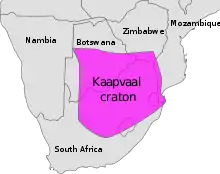craton
English

Present-day location of the Kaapvaal craton
Etymology
From Ancient Greek κράτος (krátos, “strength, might”).
Noun
craton (plural cratons)
- A part of the Earth’s crust that has survived the splitting and merging of continents.
- 1988, L. L. Sloss, Chapter 1: Introduction, L. L. Sloss (editor), Sedimentary Cover—North American Craton: U.S., Geological Society of America, The Geology of North America, Volume D-2, page 2,
- Application of the concept of a craton circumscribed by surrounding miogeosynclines was particularly vexing to stratigraphers whose study areas extended across the line theoretically delineating distinct tectonic terranes.
- 2008, Nasser Ennih, Jean-Paul Liégeois, The boundaries of the West African craton, with reference to the basement of the Moroccan metacratonic Anti-Atlas belt, N. Ennih, J.-P. Liégeois (editors), The Boundaries of the West African Craton, Geological Society, Special Publication Number 297, page 1,
- Although cratons are not tectonically active, they can be located near active margins, such as the Brazilian craton at the rear of the Andean active margin.
- 2009, Ram Sharma, Cratons and Fold Belts of India, Springer, Lecture Notes in Earth Sciences, LNES 127, page 58,
- The Bastar craton (BC) is also called Bastar-Bhandara craton. It lies to ENE of the Dharwar craton (DC), separated from the latter by the Godavari rift (see Fig. 2.1).
- 1988, L. L. Sloss, Chapter 1: Introduction, L. L. Sloss (editor), Sedimentary Cover—North American Craton: U.S., Geological Society of America, The Geology of North America, Volume D-2, page 2,
Derived terms
- cratonic
- intracratonic
- metacratonic
- pericratonic
Translations
stable part of Earth's crust
|
This article is issued from Wiktionary. The text is licensed under Creative Commons - Attribution - Sharealike. Additional terms may apply for the media files.